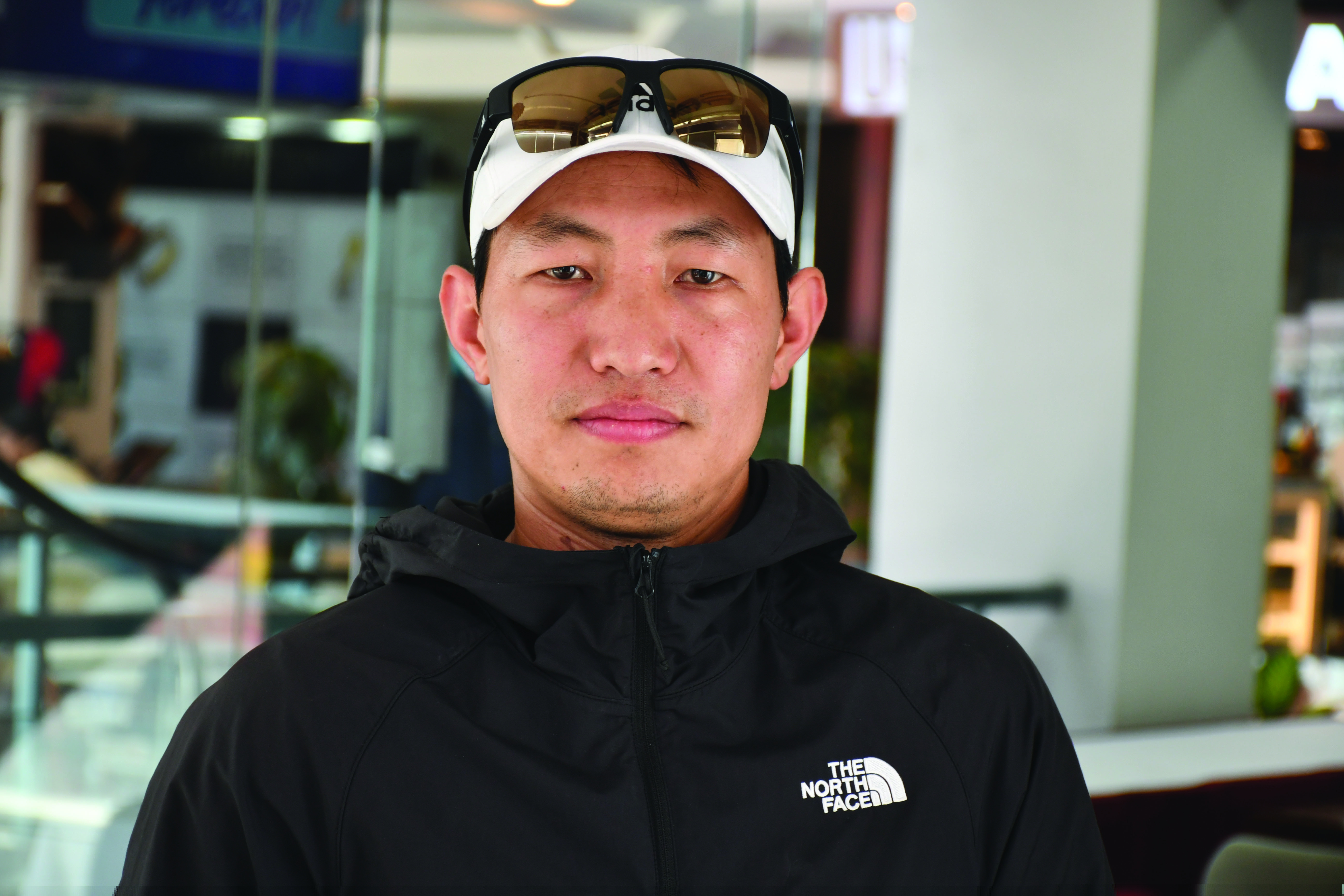Spiritual Tourism in the High Hills - Exploring Pathibhara
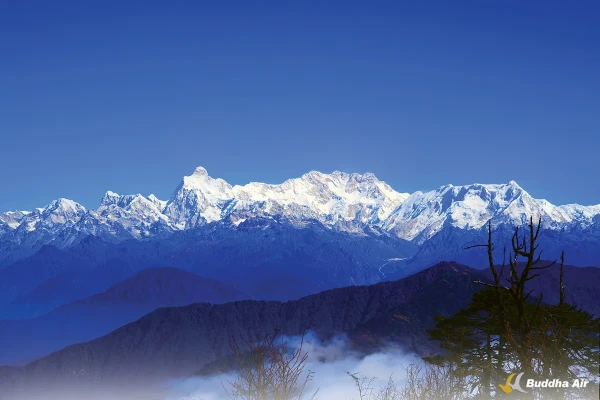
Pathibhara is a confluence of nature and spirituality. Located in eastern Nepal at an elevation of 3,794 meters, the mountain is named ‘Pathibhara’ because, from a distance, it resembles a pathi (a traditional grain measure) brimming with grain. It lies at the junction of Phungling Municipality, Sirijanga Rural Municipality, and Phaktanglung Rural Municipality in Taplejung District.
For the Indigenous Limbu community, the entire mountain is sacred and known as ‘Mukkumlung’. Hindus worship the goddess who resides at its summit, Pathibhara Devi.
From the top, visitors can take in breathtaking views of the Kumbhakarna and Kanchenjunga ranges. Looking below, the hills appear wrapped in a lake of clouds. The sunrise and sunset views are especially mesmerizing.
Mukkumlung is also rich in biodiversity. The surrounding forests are home to red pandas, various bird species, and abundant plants, trees, and medicinal herbs.
Millions of pilgrims and tourists visit the hilltop each year. Upon arrival, many describe a deep sense of peace, strength, and clarity. The union of natural beauty and divine presence brings the mind meditative calmness.
Given this unique combination, Mukkumlung is not just a pilgrimage site but also an ideal destination for spiritual tourism.
Goddess Pathibhara
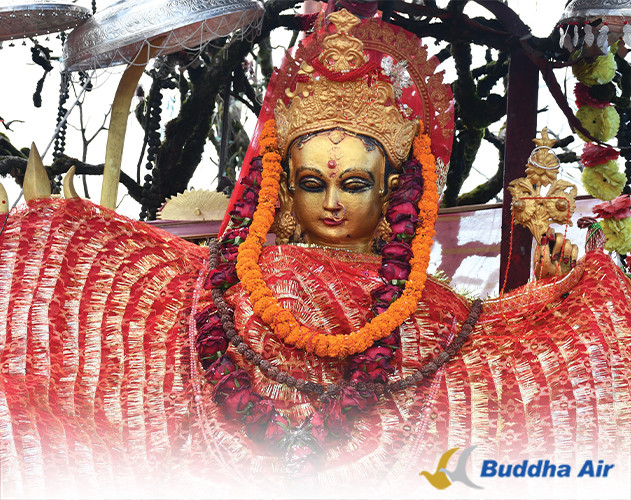
The goddess’s sacred stone was originally located below the current shrine site. It was later moved uphill for the convenience of devotees.
Pathibhara Devi is revered as a powerful Shakti Peeth (seat of divine feminine energy). The goddess is believed to be self-manifested. The hill features ancient stones and idols of deities, Ganesh, Shiva, and the Devi. A large idol of the Singhabahini goddess is also housed here. Panchakanya Kalika is said to reside at the site.
Devotees believe that visiting Pathibhara grants their heartfelt wishes. After their wishes are fulfilled, devotees return with offerings—some symbolic, others sacrificial. While in the past, animals such as ducks, chickens, goats, and sheep were commonly offered, the trend is now shifting toward non-violent offerings like coconuts and the lighting of thousands of lamps.
Devotees also offer bangles, threads, pote (a traditional necklace made of glass beads), vermilion, cash, and jewelry. The Pathibhara Area Development Committee collects all offerings; priests do not keep them personally. Priests at the temple now receive a salary.
Several legends surround the goddess's origin. According to one, a shepherd was shocked when his sheep mysteriously disappeared from the mountain pasture. That night, he had a dream in which the goddess appeared to him. She revealed the place of her origin and instructed him to sacrifice a ram there. After the sacrifice, the lost sheep were miraculously found. Since then, the goddess has been worshipped at this site.
The goddess’s sacred stone was originally located below the current temple site. It was later moved uphill for the convenience of devotees.
Today, Nepali pilgrims and visitors from India and Bhutan come to worship here. They light incense at Kanchhithan before beginning their climb to the shrine. Pathibhara becomes crowded on Saturdays and Tuesdays. Large fairs are held during Dashai and Ram Navami festivals. Although the shrine can be visited year-round, the best season is from Falgun to Kartik.
To support the development of this sacred site, the government established the Pathibhara Area Development Committee in 2053 BS. The committee has since improved hikking routes and constructed rest areas and toilets at various points along the path.
How to Reach Pathibhara?
Drive from Kathmandu to Jhapa to Phungling (approx. 22 hours). Alternatively, fly from Kathmandu to Chandragadhi (approximately 45 minutes), then drive from Chandragadhi to Phidim to Phungling (approximately 238 km/8 hours). From Phungling, drive to Suketar and Kaflepati (19.2 km / approx. 1.5 hours by jeep). Begin trekking from Kaflepati: Kaflepati to Thulo Phedi: 1.9 km, approx. 1 hour. Thulo Phedi to Pathibhara: 2.4 km, approx. 3 hours
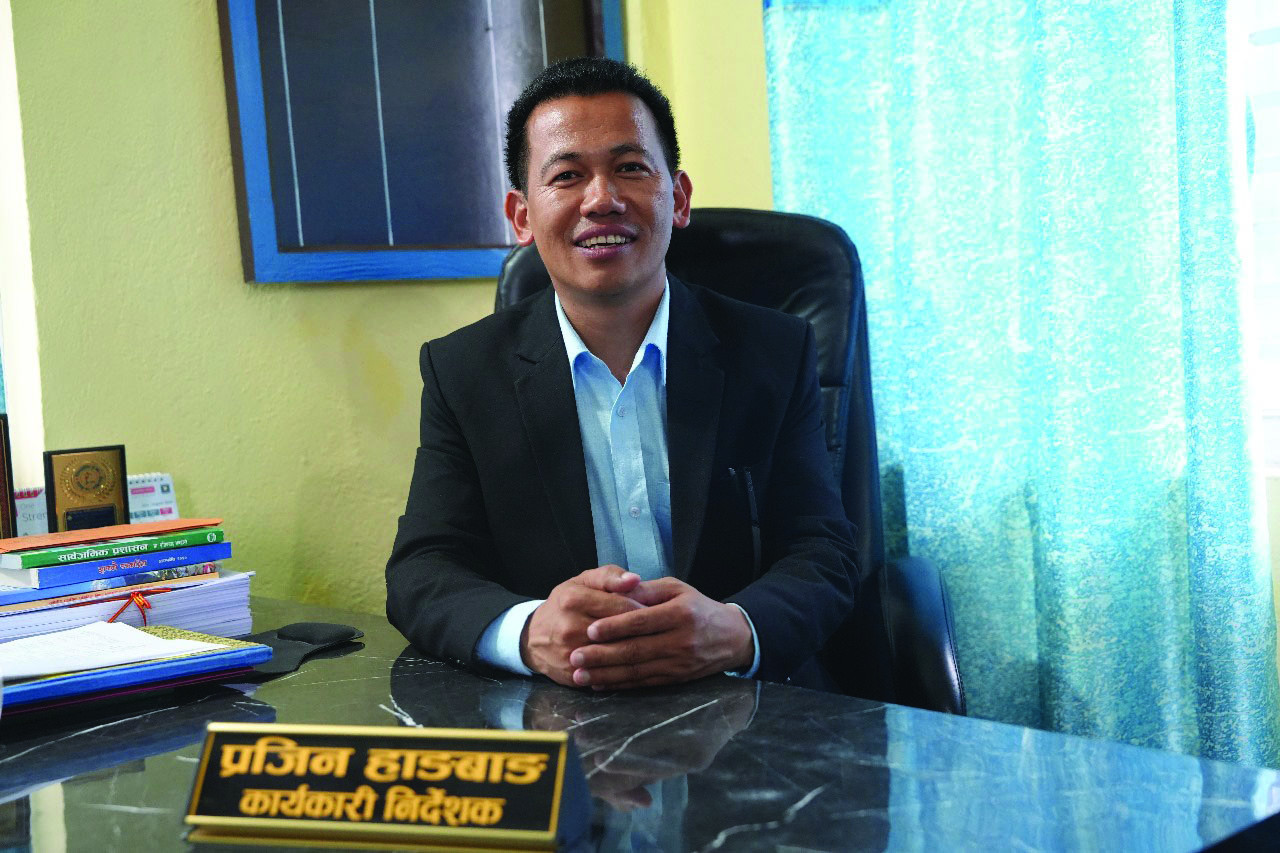 Pathibhara is an important Shakti Peeth (abode of goddess) in eastern Nepal, with religious and archaeological significance. We have formally requested the Department of Archaeology to initiate the process of listing Pathibhara as a UNESCO World Heritage Site.
Pathibhara is an important Shakti Peeth (abode of goddess) in eastern Nepal, with religious and archaeological significance. We have formally requested the Department of Archaeology to initiate the process of listing Pathibhara as a UNESCO World Heritage Site.
Prajin Hangbang
Executive Director, Pathibhara Area Development Committee
To establish Pathibhara as a model spiritual tourism destination, we are developing essential infrastructure, ensuring visitor safety, and organizing offerings. We also use drilling technology to extract drinking water directly from the hill.
Rocky Thebe
Chairman, Pathibhara Area Development Committee
Mukkumlung
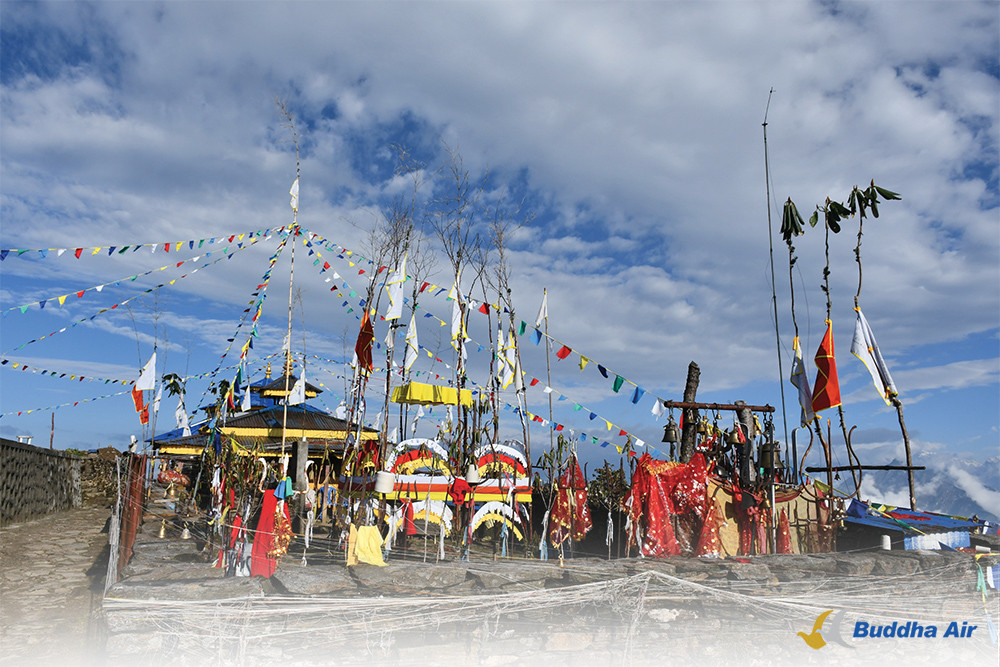
The Limbu community, known for their deep reverence for nature, worships the entire hill of Mukkumlung as a symbol of power.
On clear days, the hill offers breathtaking views of Makalu, Kumbhakarna, and Kanchenjunga. Among these peaks, Kumbhakarna is particularly revered by the Limbu people, who call it Phaktanglung. It is considered a major pilgrimage site, reflecting the community’s deep spiritual connection to the land.
Historically, Taplejung district lies within the traditional territory of Limbuwan. The Limbu people worship what is widely known as Pathibhara under its original name, Mukkumlung. In the Limbu language, ‘Muk’ means “center of power," and ‘Lung’ means “stone.” Hence, Mukkumlung signifies a “stone of power” or the “goddess of power.”
Guided by their oral scripture Mundhum, passed down through generations via the Shruti tradition and preserved by priests, the Limbus continue to practice nature worship.
They believe the hill is a place to attain spiritual power, and their goddess Yuma resides there.
At the peak of Mukkumlung stand Mangnisha and Mujolung. Nearby, a Manghim (a sacred shrine or “God’s house”) has been constructed. Outside the shrine is a pavilion housing statues of Mahaguru Phalgunanda, a revered spiritual leader, and Chhyabrung, a traditional Limbu musical instrument symbolizing cultural heritage.
During a pilgrimage to Mukkumlung, a significant ritual involves hanging a thread from Kanchhithan to the summit. This thread is believed to represent the cycle of life, symbolizing the connection from birth to death. The sacred sites where looms were woven, the source of water, and the spiritually significant trees, as mentioned in Mundhum, are all located in Mukkumlung. Hence, Mukkumlung is a sacred site of Mundhum practices.
Over time, with the influence of the Khas-Arya community, the original name Mukkumlung began to be replaced by Pathibhara. A movement has emerged to preserve and restore the site’s original identity. Advocates call for the state to recognize and protect Mukkumlung as a Mundhum cultural heritage site.
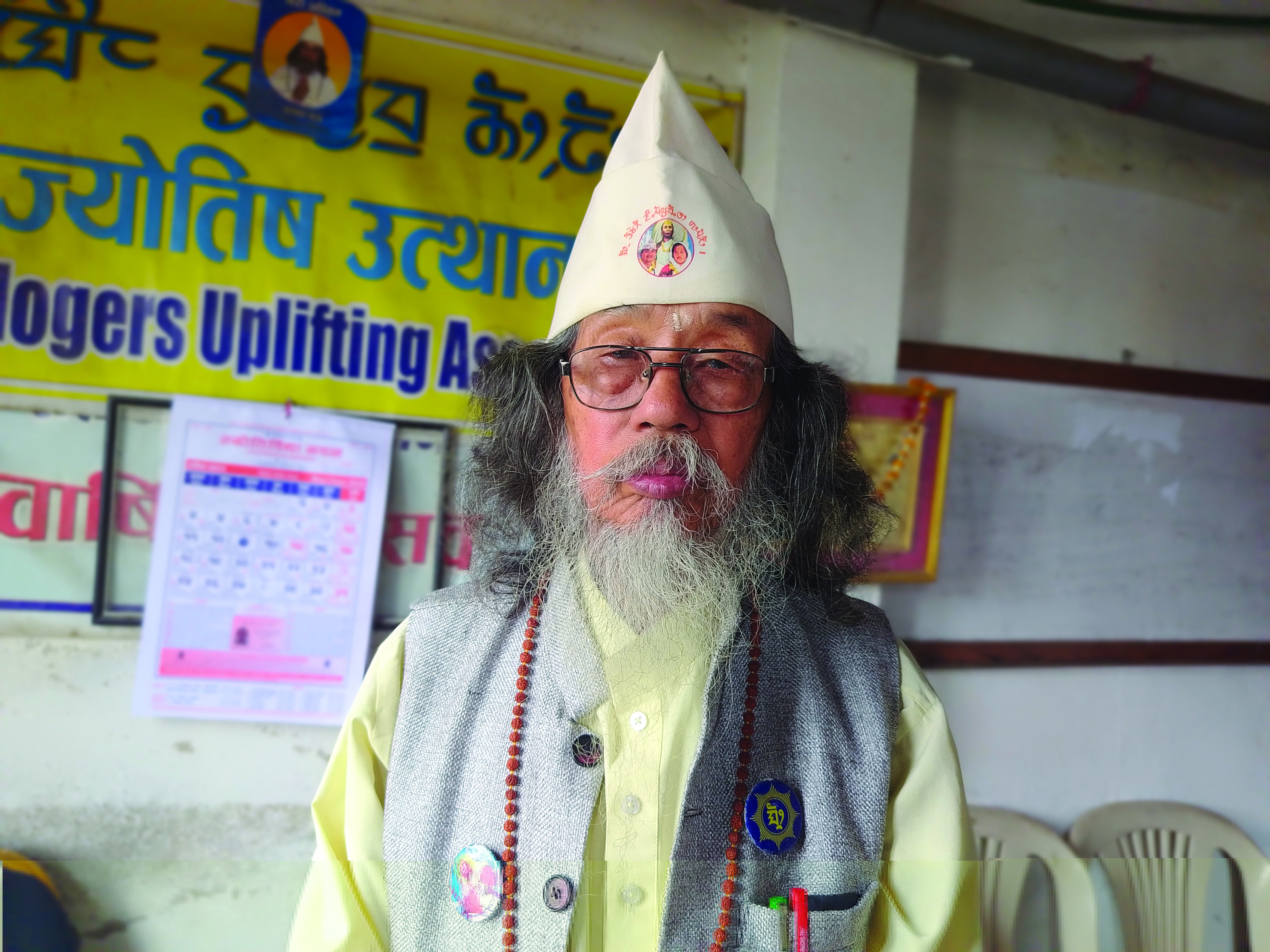 Mukkumlung is a sacred land. The state must consult local religious leaders and residents when developing religious sites like this. No work should be imposed forcefully. Violating this sanctity may invoke divine consequences.
Mukkumlung is a sacred land. The state must consult local religious leaders and residents when developing religious sites like this. No work should be imposed forcefully. Violating this sanctity may invoke divine consequences.
Dr. Chandra Kumar Sherma
Mundhum Expert
Gumbadanda Homestay
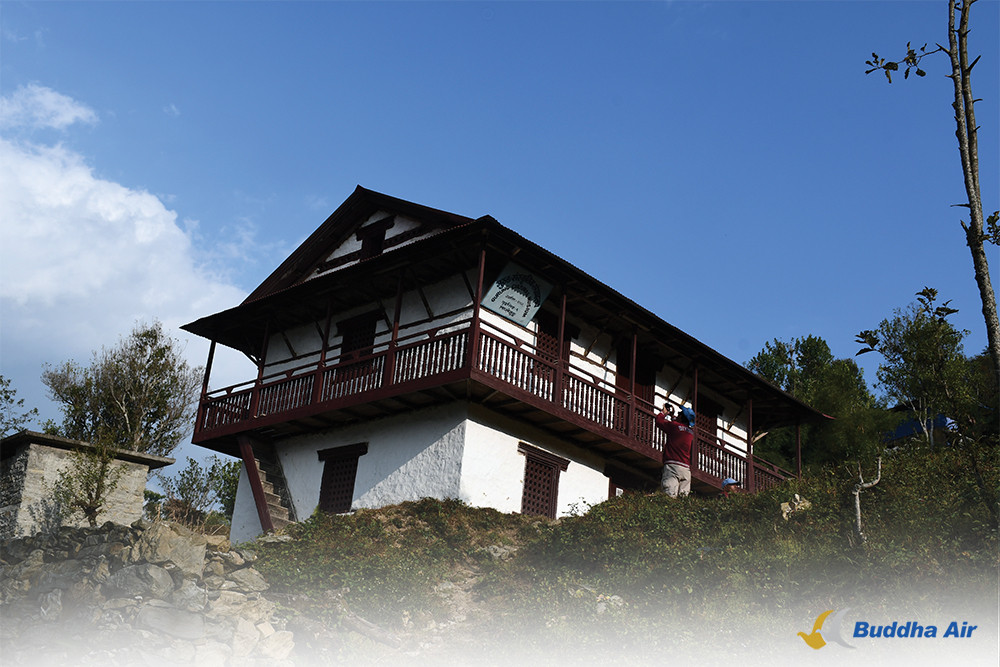
Homestays offer two major benefits: affordable food and lodging and the warm hospitality and blessings of the local villagers.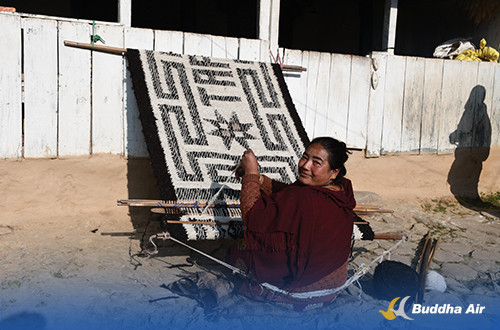
Above Phungling Bazaar, the district headquarters of Taplejung lies a picturesque village named Gumbadanda. Nearby is the Buddhist Monastery, which houses statues of Shakyamuni Buddha, Guru Padmasambhava, and Avalokiteshwor. Outside the monastery, prayer flags flutter in the wind, carrying Buddhist mantras.
The village gets its name from this monastery–Gumba means monastery and danda means hill. Gumbadanda lies in Ward No. 6 of Phungling Municipality and is home to around 100 households, primarily of the Gurung community. Of these, 16 houses offer homestay services.
Established in 2069 BS, the homestay program was launched to provide food and lodging for Pathibhara tourists. Guests are served local dishes in clean and welcoming guest rooms. On request, cultural programs showcasing traditional Gurung music and dance are also organized.
Many of the village’s youth work abroad, while the locals grow potatoes, corn, and millet. They also raise cows, goats, and chickens.
Meals at the homestay feature home-grown vegetables and seasonal produce like kiwis, apples, and pears, along with dal-bhat (lentils and rice) and traditional millet porridge.
Gumbadanda is more than just a place to stay. It is worth visiting for its natural beauty and cultural richness. Visitors can explore the Gurung Cultural Museum, Mahadev Pond, temples, and monasteries and experience authentic rural life. The village is also a viewpoint of Phungling Bazaar and offers scenic views of Kanchenjunga Himal.
It’s recommended that you inform the homestay in advance and arrive before sunset so the hosts can make the necessary preparations.
These days, Gumbadanda is not only a stop for pilgrims but also a popular weekend getaway for residents of Phungling Bazaar.
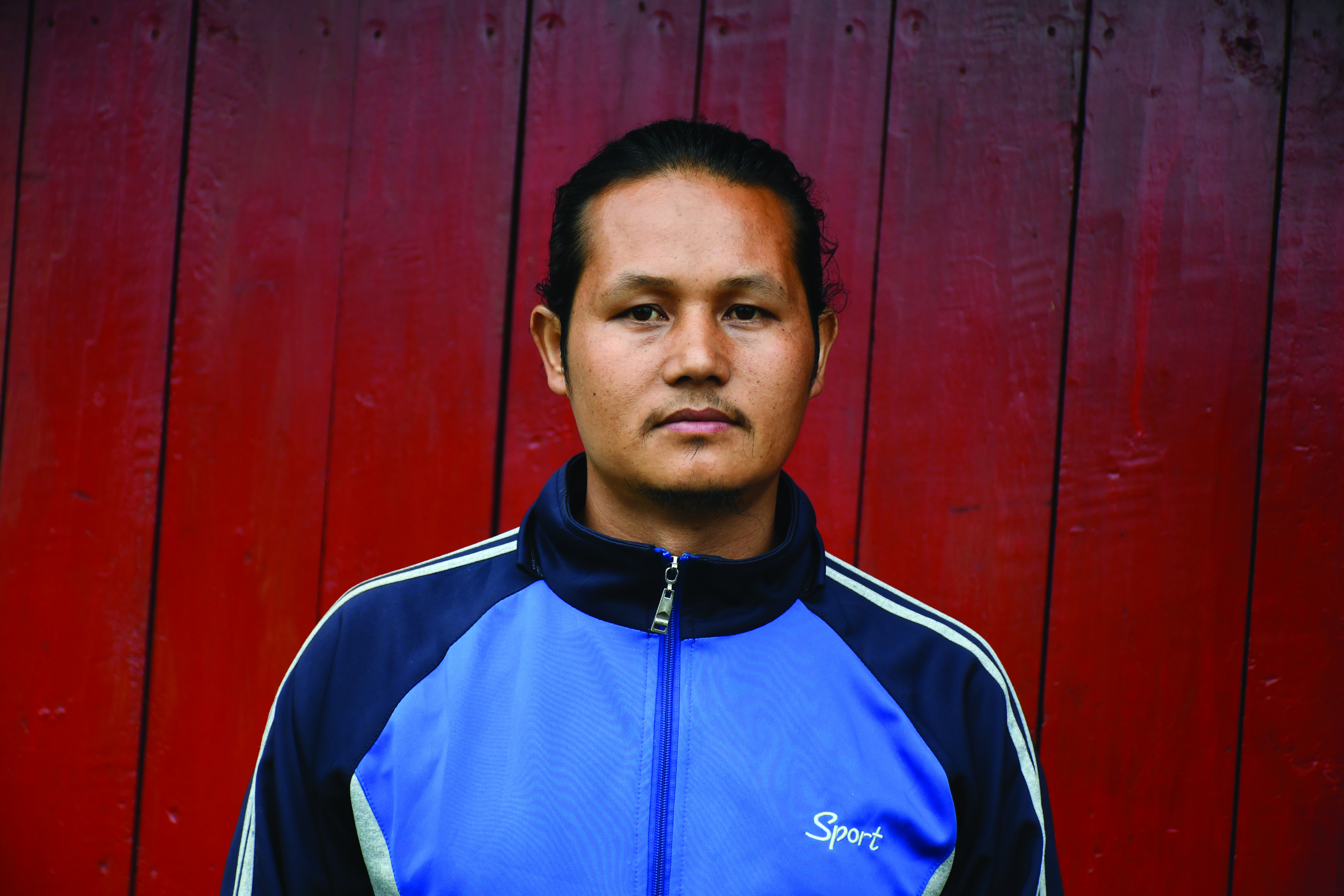 Cheap and Delicious
Cheap and Delicious
- Maniraj Gurung, President, Gumbadanda Community Homestay
Our village has 16 houses that can host up to 50 guests. We offer food and lodging in a warm, family-like atmosphere. A plain meal costs Rs.200, a chicken meal Rs.350, and snacks Rs.100. The charge for a bed is Rs.250.
Contact: 9863697562
Phungfunge Waterfall
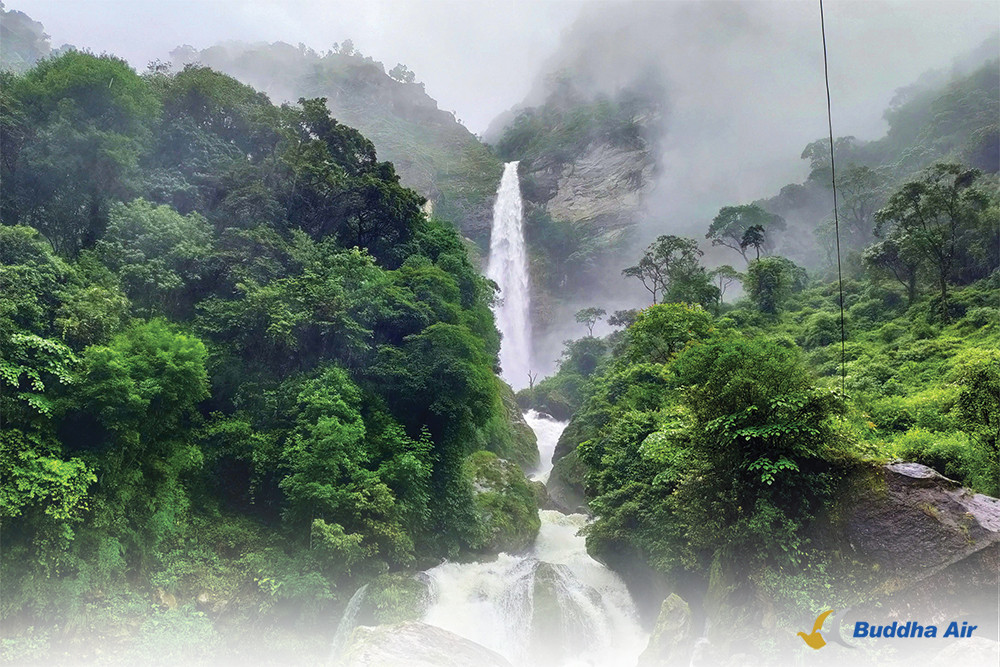
A cultural monument called Silamsakma, a symbol of Limbu heritage, has been installed in the waterfall area. The waterfall in the background adds to its striking visual appeal.
This stunning waterfall cascades down a massive rocky cliff, appearing white as milk. The name “Phungfunge” comes from the distinctive sound the falling water makes—phung-phung. The waterfall is located in Ward No.4 of Mikwakhola Rural Municipality in Taplejung district.
The waterfall's original name is Phongfongden, but due to linguistic changes and erosion, it came to be known as Phungfunge. It stands approximately 180 meters tall.
Set amidst lush green hills, the waterfall is a breathtaking sight. Standing at its base, one can feel the cool spray and breeze from the falling water, a refreshing experience revitalizing the senses.
At the base of the waterfall is a small pond, and nearby is a temple dedicated to Phungfunge Devi, who is worshipped as a symbol of power. Visitors often come to enjoy the natural beauty and offer prayers to the goddess, hoping to fulfill their wishes. The Limbu community organizes fairs at this site during major festivals such as Udhauli and Ubhauli.
The Silamsakma structure, a key representation of Limbu identity, enhances the cultural atmosphere of the waterfall area, with the scenic backdrop of the falls adding to its beauty.
We run a community homestay near the waterfall. Homestay facilities are available in nine houses belonging to the Limbu community. We serve traditional local dishes to our guests. A non-vegetarian meal (pork, chicken, or goat) costs Rs. 350, a vegetarian meal costs Rs. 250, and a bed is available for Rs. 100.
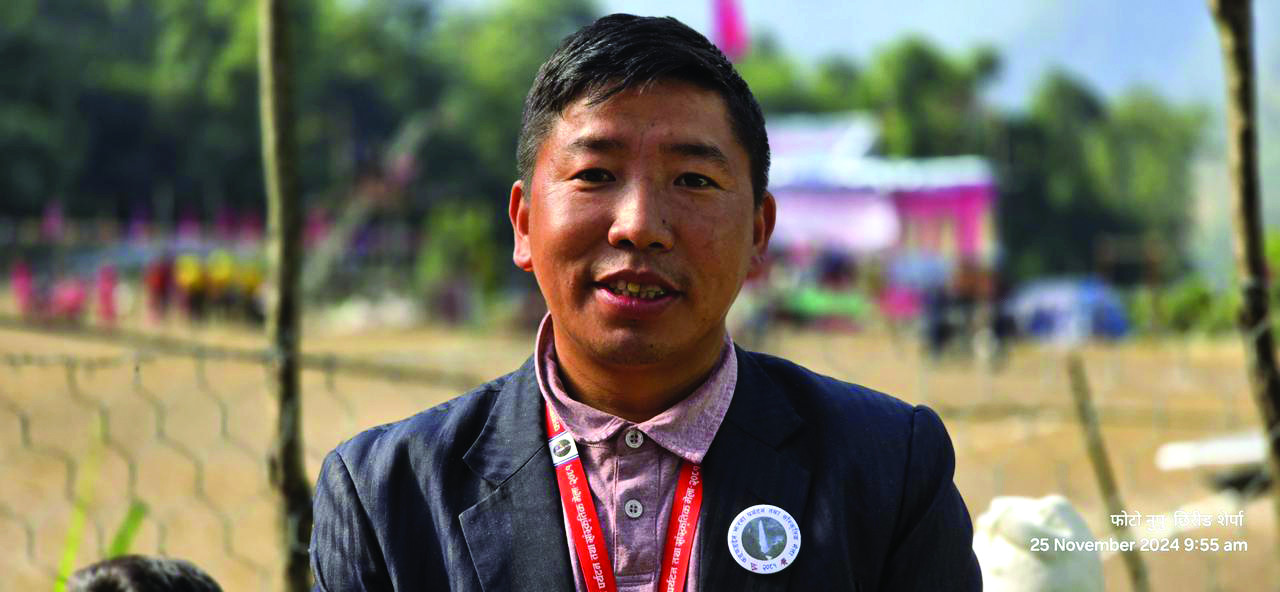 We run a community homestay near the waterfall. Homestay facilities are available in nine houses belonging to the Limbu community. We serve traditional local dishes to our guests. A non-vegetarian meal (pork, chicken, or goat) costs Rs. 350, a vegetarian meal costs Rs. 250, and a bed is available for Rs. 100.
We run a community homestay near the waterfall. Homestay facilities are available in nine houses belonging to the Limbu community. We serve traditional local dishes to our guests. A non-vegetarian meal (pork, chicken, or goat) costs Rs. 350, a vegetarian meal costs Rs. 250, and a bed is available for Rs. 100.
Bijaya Prakash Limbu
Homestay Operator
Contact: 9869856912
The waterfall originates from the Phungfunge River, whose waters eventually flow into the Mewa River. Water from the falls is also channeled through a tunnel to generate electricity. The Madhya Mewa Hydropower Company produces 73 megawatts of power from this system.
Phungfunge Waterfall was listed among Nepal’s top 100 tourist destinations during the ‘Visit Nepal Year 2020’ campaign. It also holds potential for adventure activities such as canyoning.
Visitors can find food and lodging in Temba village, near the waterfall, where hotels and community homestays have been established. Guests can spend the night there and explore not only the waterfall but also the surrounding villages and learn about the Limbu community’s lifestyle and traditions.
The waterfall lies 32 kilometers from Phungling Bazaar, the district headquarters of Taplejung. Due to the off-road terrain, reaching by jeep takes about three hours. A road built by the hydropower company leads directly to the waterfall's base.
Additionally, visitors can embark on a two-day trek from Phungfunge to reach the scenic village of Topkegola.
Timbung Pokhari
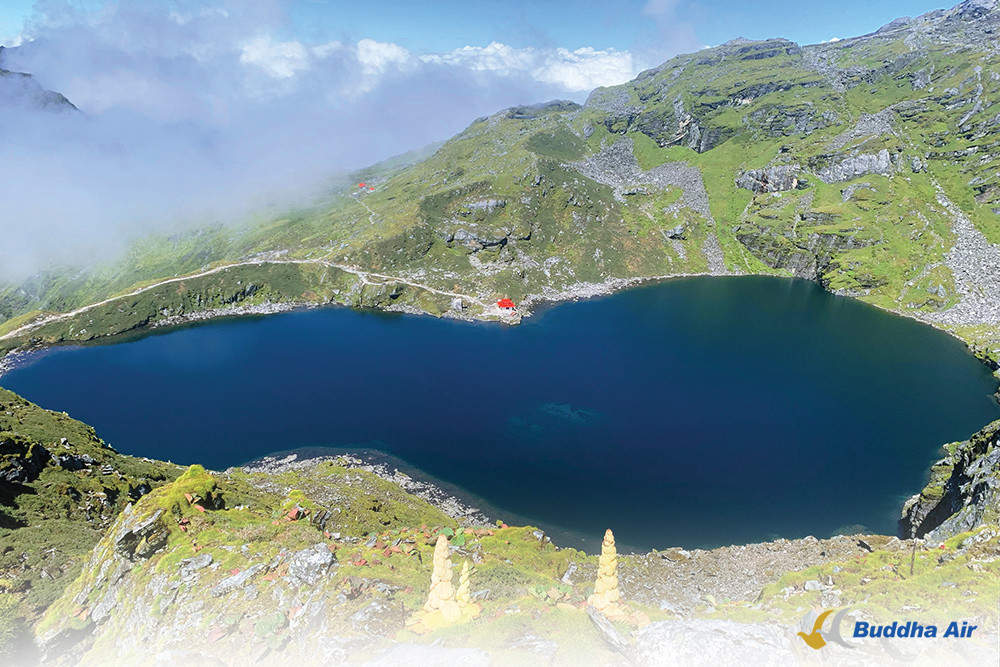
Yaks grazing in alpine meadows, blooming kenjo (Padamchal), and the shimmering blue waters of the pokhari–just the memory of it lifts the mind and transports it to Timbung.
Timbung, situated at an altitude of 4,350 meters, is a unique gift of nature. Located within Sidingwa Rural Municipality of Taplejung and Yangwarak Rural Municipality of Panchthar, the lake is mesmerizing. Simply imagining blooming alpine flowers and yaks grazing peacefully by the lakeside is enough to stir the heart.
In earlier times, locals reported hearing sounds like gunfire from the lake. Because of this, the Limbu community named it Timmak Barak, where Timmak means "gun" and Barak means "lake" in the Limbu language.
The Timbung area is not home to just one lake but a cluster of them. Among them are Handi Pokhari, Kanchhi Pokhari, Hans Pokhari, Jumlyaha Pokhari, Dhunge Pokhari, Lam Pokhari, Ramlakshman Pokhari, and Laxmi Pokhari.
A traditional fair is held at Timbung Lake every year during Janai Purnima and Nag Panchami. It is believed that attending the fair and offering prayers here can fulfill one’s wishes.
Over time, Timbung has emerged as a popular trekking destination. With well-established trekking routes from both Taplejung and Panchthar districts, it attracts a growing number of domestic trekkers. Many trekkers enter via Taplejung and return via Panchthar, making it a circular route.
From Timbung Top (4,650 meters), which lies just above the lake, trekkers are rewarded with breathtaking views of the Himalayas. Majestic peaks such as Makalu, Kumbhakarna, Kanchenjunga, and Mount Everest can be seen. On clear days, one can also spot the border settlements of Sikkim and Darjeeling.
The river that originates from this sacred lake connects the Taplejung and Panchthar districts. It is called the Iwa Khola, also known as Indrawati.
The Timbung region is also rich in biodiversity. Medicinal herbs like kenjo (Padamchal), Vishuma, Jatamasi, and Panchaunle are found here. The area also supports Himalayan wildlife such as Ghoral (mountain goat), Naur (Himalayan blue sheep), bears, and snow leopards, as well as birds like danphe (Himalayan monal) and chili (blood pheasant), making it ideal for ecological studies.
Though the lake can be visited year-round, the best trekking season is from Baisakh to Mangsir. Hotels and homestays are available along the way for those taking the route from Taplejung.
Travelers from Jhapa should set aside five days for the journey to Timbung pokhari. On Day 1, drive from Birtamod to Kali Khola in Taplejung. On Day 2, trek to Nunthala. On Day 3, continue the trek to Timbung Pokhari. Spend Day 4 exploring the lake and descend to Kali Khola. Return to Birtamod by jeep on Day 5.
We run a guest house near Timbung Pokhari. For just NRs. 1000, Nepali guests can enjoy dinner, a bed, and morning tea. We also organize guided tours for those visiting the nearby Sikkim border.
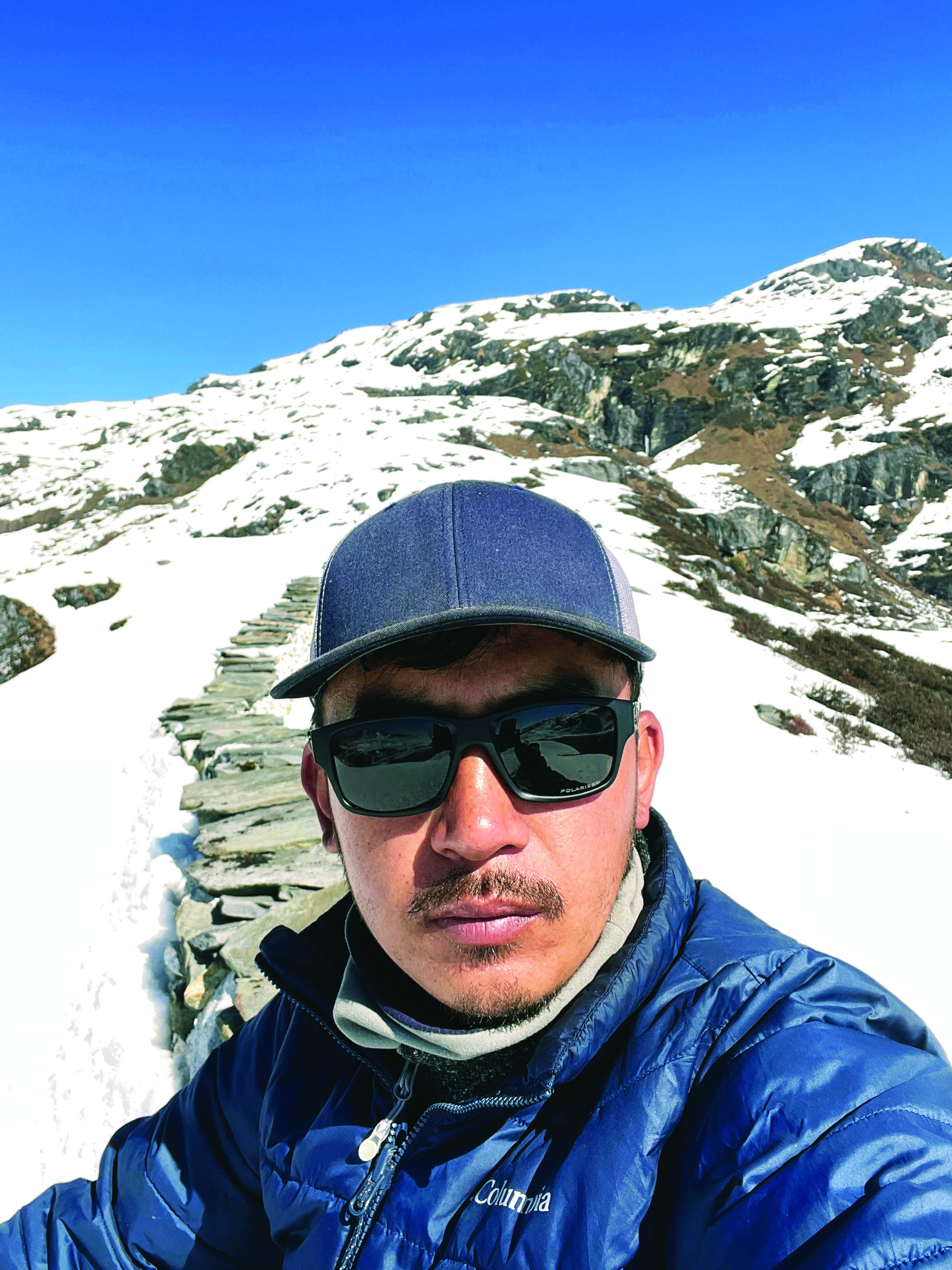
We run a guest house near Timbung Pokhari. For just NRs. 1000, Nepali guests can enjoy dinner, a bed, and morning tea. We also organize guided tours for those visiting the nearby Sikkim border.
Amir Rai
Operator, The Red Panda Guest House
Contact: 9745866620
Hilihang Palace
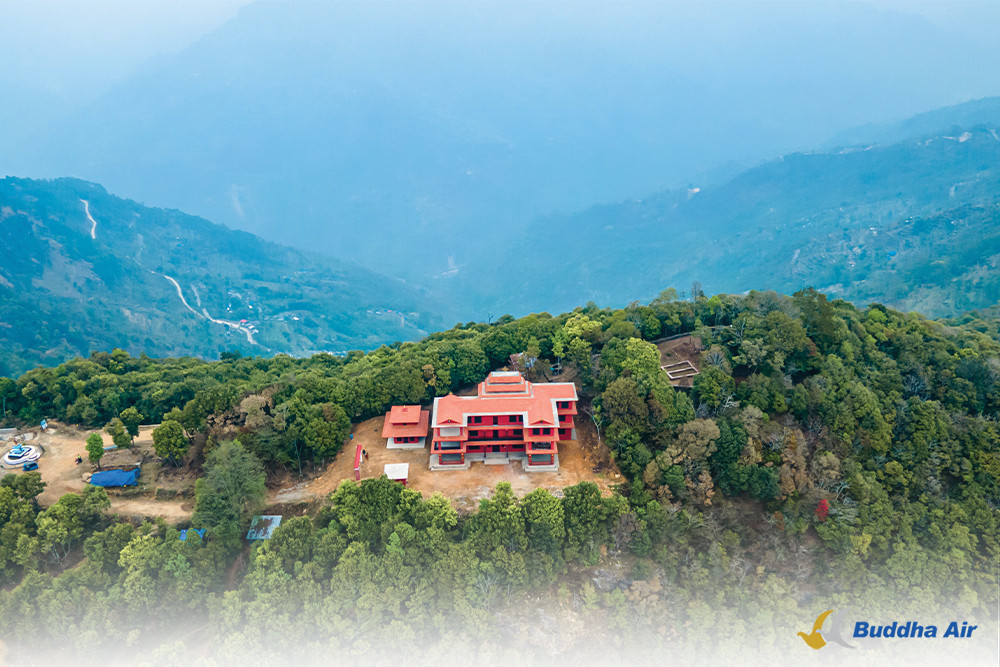
Hilihang played a significant role in the empowerment of the Limbu community and in the unification of Nepal.
The last king of Limbuwan, Hilihang Yonghang, was a contemporary of King Prithvi Narayan Shah. He was born in 1783 BS and died in 1844 BS, ruling for 30 years from 1814 to 1844 BS.
Despite 17 attempts, King Prithvi Narayan Shah’s Gorkhali forces could not conquer Hilihang during the unification campaign. Eventually, a peace agreement was signed on 22 Shrawan 1831 BS, ending the conflict.
The palace of this powerful Limbu king is located on a hill in Panchthar Rural Municipality Ward No. 4. A pagoda-style palace has been excavated at the site and reconstructed with beautifully designed entrance gates and a statue of King Hilihang, adding to its historic charm.
A museum has also been established in the palace area. It aims to display artifacts such as shields, swords, axes, khukuris, war marks, and documents from the peace agreement, all used or signed by King Hilihang during the battles with the Gorkhalis. Bunkers and other objects of archaeological importance can also be seen here.
The palace site is not only historically significant but also a scenic viewpoint. From here, one can witness the majestic landscapes of Makalu, Kanchenjunga, Kumbhakarna, and the surrounding Panchthar and Tehrathum districts. Nearby attractions include Jorpokhari, Ageyjung Gumba, Kalapani, Milung Falls, and Bhotegadhi.
Visiting the palace evokes a deep pride in the region’s history. Hilihang’s legacy is remembered for his leadership of the Limbus and his contribution to the broader national unification process.
In recognition of his contribution, the area has been named Hilihang Rural Municipality, which was formed by merging the former Amarpur, Panchami, Subhang, and Bharpa VDCs.
The palace is located approximately 3 kilometers from Hilihang Chowk, along the Phidim–Taplejung section of the Mechi Highway.
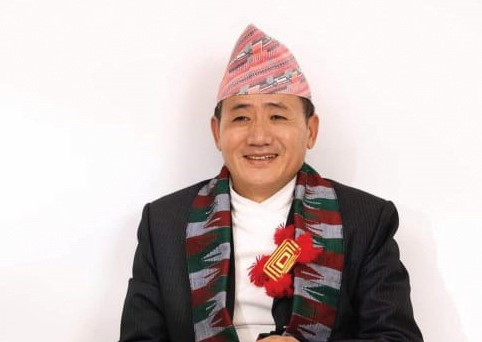 Spokesperson of Hilihang
Spokesperson of Hilihang
Harka Bahadur Yonghang, founding chairman of the Hilihang Foundation, is a unique blend of historian, cultural thinker, and literary writer. Since 2048 BS, he has been dedicated to researching and preserving the legacy of Hilihang.
"A commitment to preserving one’s identity brings deep satisfaction," he says. "I will continue the campaign to promote Hilihang Palace as a world-renowned tourist destination."
Yonghang has authored a few books, including ‘Hilihang in the History of Nepal’ and ‘History of Nepal.' He is also preparing to publish a collection of literary articles and a new book titled ‘Yakthung Mundhum can be a Guru of Science!’ In addition, he writes songs and poems.
Born in Gairigaun of Ekatappa Rural Municipality-8, Ilam, he currently runs a tea shop named ‘Hilihang Green Tea’ in Anamnagar, Kathmandu, to support himself.
Best wishes to Yonghang!
Contact: 9851091156
Souvenirs
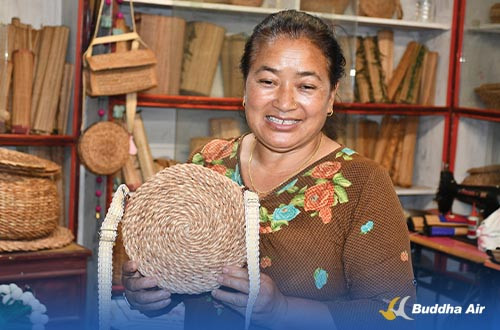
Entrepreneur Maya Gurung creates a variety of handicrafts using cardamom fibers.
If you're visiting Taplejung, bringing souvenirs for family, friends, and well-wishers is customary. Popular local products include chhurpi (hardened .cheese), chauri ghee (yak butter), hand-woven carpets, radipakhi (traditional rugs), honey, Dhaka fabric, sukuti (dried meat), akbare khursani (round chili), beans, and gundruk (fermented leafy greens). These items can be purchased from shops in Kaflepati, Phungling Bazaar, and Suketar.
Another unique gift from Taplejung is the range of products made from cardamom fiber. Maya Gurung, an entrepreneur from Phungling Bazaar, founded her handicraft business in 2068 BS. She produces around 60 items, including bags, purses, mats, vases, mudha (stools), baskets, and blankets.
Her primary market is in Kathmandu, but many travelers heading abroad also purchase her products as souvenirs. Currently, her enterprise employs 15 people. Honored as a model entrepreneur, Gurung also conducts handicraft training programs in various regions, empowering others with her skills.
Contact: Chandan Fiber Industry, Phungling Bazaar
Maya Gurung- 9842639869
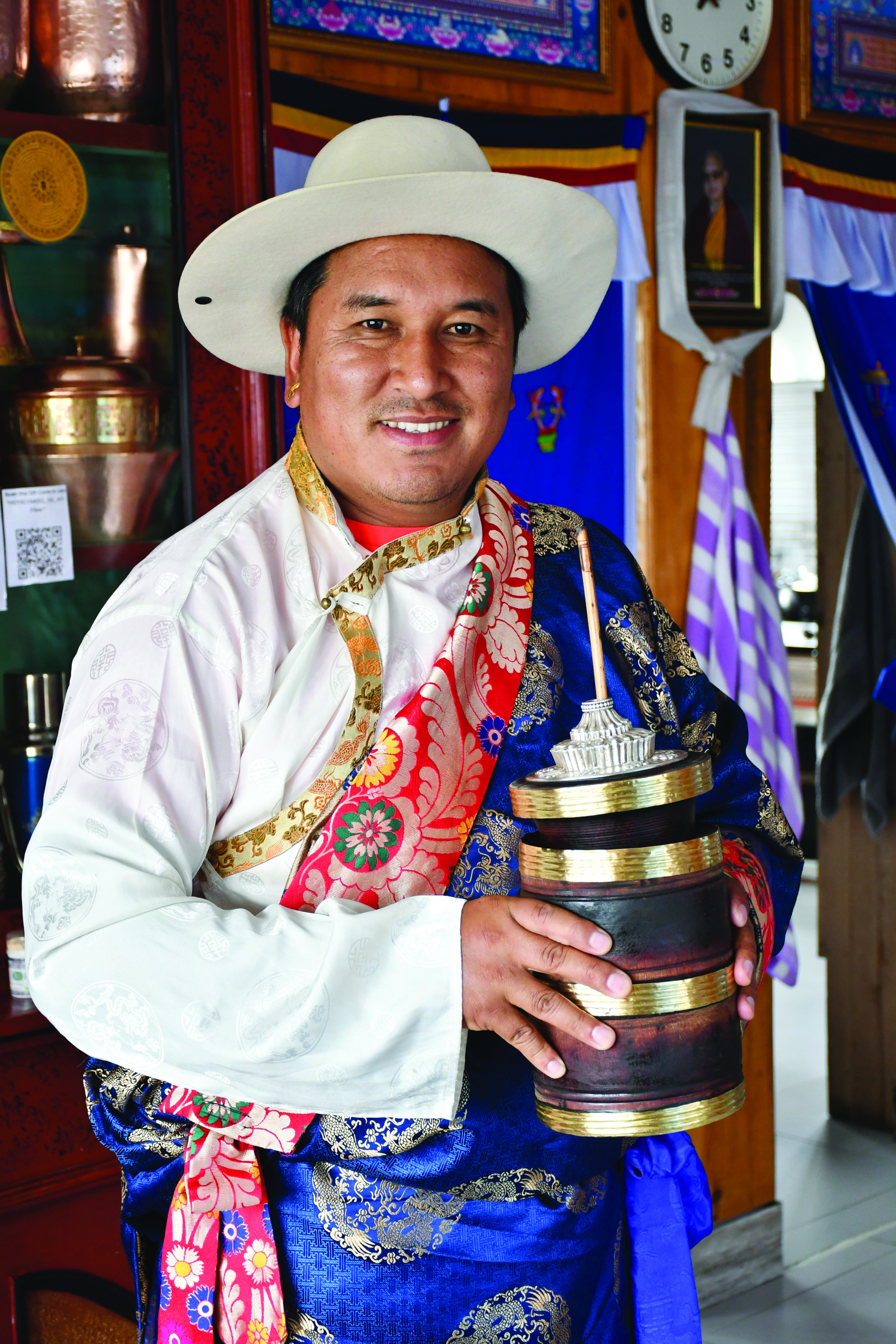 Tongba
Tongba
Tongba and sukuti are among the most popular traditional delicacies of Taplejung.
Tongba is a traditional homemade alcoholic beverage widely enjoyed in the region. It is made by fermenting millet and placing the fermented mash into an intricately carved wooden vessel. Hot water is poured over the mash and steeped for about 15 minutes. The resulting warm alcoholic drink is sipped through a metal or bamboo straw called a pipa.
The name tongba refers to both the drink and the wooden container it's served in. These vessels are typically made from ‘daar’ wood. Traditionally, the pipa was made from malingo (a type of bamboo), but nowadays, both the vessel and the pipa are often made from aluminum. In Taplejung, however, the traditional wooden vessels are still commonly used.
Tongba is especially popular in cold weather, as it helps warm the body. Hot water is added to the fermented mash multiple times–often four to five times–until the flavor is fully extracted. It is usually enjoyed alongside sukuti (dried meat), with buffalo sukuti being a local favorite.
In Suketar, Pasang Bhote and his wife Chhoki run Hotel Yak, a cozy establishment they’ve managed since 2065 BS. The hotel has seven rooms and offers a warm welcome to visitors. Pasang proudly says, “Don’t leave Suketar without tasting our Tongba and Sukuti!”
Contact : Hotel Yak, Suketar
Pasang Bhote- 9852660009
Bali Guru
Dil Bahadur Karki, who performs the ritual slaughter of sheep, goats, chickens, and other animals brought by pilgrims, is known as the Bali Guru (Master of Sacrifice).
Now 60, Karki has been doing this work since the age of 16. Sacrifices are especially common during major festivals such as the first nine days of Dashain, called Navaratha, Ram Navami, and on Tuesdays, which are considered auspicious days for worship at Pathibhara. He receives offerings and cash donations from pilgrims as his remuneration. Another individual also assists in performing these rituals.
While his family lives in Sansare, near Birtamod in Jhapa, Karki resides in Pathibhara to carry out his work.
Contact : Dil Bahadur Karki- 9844264191

